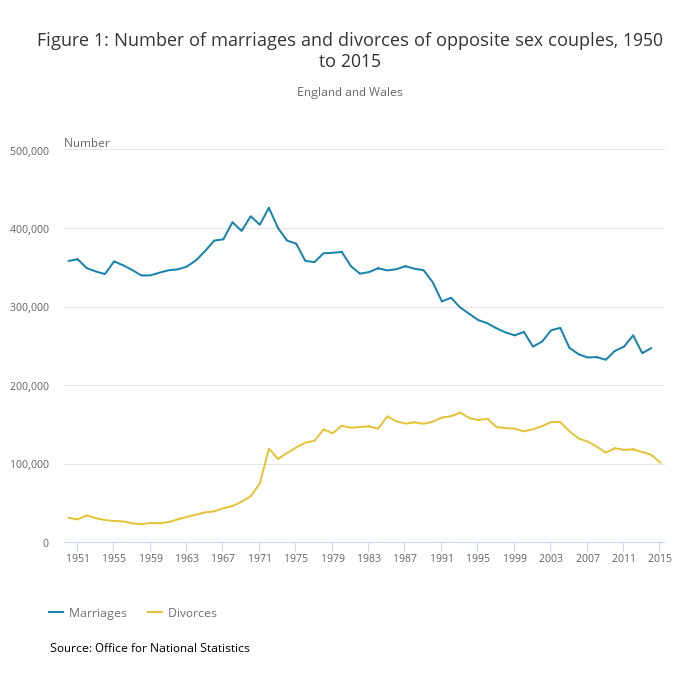We’ve all heard the saying time and time again: “half of all marriages end in divorce”. There has been a dramatic change in societal attitudes towards marriage and divorce over the past several decades, and it is generally perceived that laxer attitudes towards divorce equals the divorce rate increasing. But is this really the case? And do half of all marriages really end in divorce?
The ONS estimates the current divorce rate in the UK is in fact around 42%, and in 2015, there were 101,055 divorces in England and Wales. This seems like a large number indeed, but it is a considerable decrease of 9.1% compared with 2014’s figure, and a decline of 34% from a peak in 2003.
The 1970s saw a huge surge in divorce rates. This was partly down to changing social attitudes, but another significant reason for the surge was the introduction of the Divorce Reform Act in 1971, which meant that couples were finally allowed to divorce on the grounds of separation. The divorce rate continued to climb into the 1990s, but since then it has been steadily declining.

So, why is divorce on the decrease?
The most likely explanation for the decrease in the number of divorces is the boom in cohabitation. In the first half of the 20th century it was generally not considered the norm for couples to cohabit without being married, and of course that attitude has changed dramatically.
In 2017, for most people there is little or no stigma attached to cohabiting, and as a result of this societal change the marriage rate in the UK has been gradually decreasing for several decades. This is most likely due to the fact that it is now the norm for couples to try out cohabitation before making the decision to get married, and have the chance to break up before tying the knot if they find that it doesn’t work out. Many couples also choose to never marry at all.
So, it is apparent that the falling number of divorces is rather a reflection of the declining popularity of marriage.
This change in attitudes towards marriage and divorce also means that although fewer couples are choosing to marry, the ones that do tend to be together for longer. The median duration of a marriage has gradually crept up to 11.9 years since 1985, from a low of 8.8 years.
Times of economic recession also appear to have an effect on divorce rates. For example, from 2003 to 2009 the rate was gradually decreasing – but in 2010 (two years after the 2008 global financial crash) the number of divorces increased by 4.9%. This could be due to a couple of reasons. Firstly, the squeeze on household finances in a recession leads to additional strain on relationships and can drive people to decide they can no longer continue with the marriage. The other reason often theorised is that when the recession comes to an end and economic prospects are looking up, the idea of finally being able to afford a divorce encourages couples to take the plunge and start divorce proceedings.
In summary
Living together ‘out of wedlock’ no longer has a stigma attached, and the lower number of marriages means divorce is generally decreasing overall. But divorce also no longer has the same stigma it used to carry in society – and perhaps for this reason couples do not feel obligated to stay in unhappy marriages as they may have felt historically. But whatever the reason, relationship breakdown is something that many thousands of Brits go through every year and come out the other side.
Crisp & Co’s specialist divorce solicitors are here to help when it comes to the breakdown of a marriage. We understand that no two families are the same - we can provide a tailored service, helping to protect your interests and come to the best possible solution for you and your family. For more information on how we can help, call us today on the number above or send us an enquiry.


